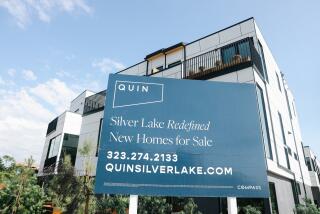Home Values Showing Their Appreciation
- Share via
WASHINGTON — The American home value appreciation machine keeps pumping out near-record inflation-adjusted gains.
The latest data from the government agency that tracks the appreciation rates of millions of individual homes reveal that the average gain nationwide during the last year has been close to 5%, about four times the rate of inflation.
Houses in a few states have done even better. The typical California home jumped by 8.3% in value from the first quarter of 1998 through the first quarter of 1999. Massachusetts homes were up 7.9% in the same period, Michigan homes were up by 6.1%, Georgia homes by 6% and Colorado homes by 5.8%.
What does a 5% appreciation rate mean to you as a homeowner or prospective buyer?
Faster and more substantial tax-free equity growth than you might imagine, thanks to the magic of compound interest. For example, a house you buy for $200,000 in a 5% appreciation market this weekend turns into a $231,000-plus house in three years and a $255,000 house in five years. Of course, that’s assuming a continuation of today’s economic conditions, which no one can forecast.
But forecasts aside, the statistical evidence is strong that, even with relatively short periods of softness in regional markets, homes nationwide have produced impressive capital gains for owners over the last 20 years.
Consider these findings extracted from data compiled by the Office of Federal Housing Enterprise Oversight, an agency that conducts quarterly market-value research on a national sample of 11.5 million houses it tracks through repeat sales and refinancings:
* A typical home purchased in New England in 1980, before the super-inflationary run-up of the late 1980s, and held through the retrenchment of the 1990-1992 recession is worth more than three times what it cost 19 years ago.
You do the math: What was a $150,000 house is now a $450,000-plus house, what was a $250,000 house now sells for more than $750,000 and so on.
* The average home purchased in the United States in 1985 has more than doubled in resale value.
Homes in a few states have produced astounding returns for their owners--almost on the scale of stock market yields--in the last five years. The typical house in Utah is worth nearly 50% more than it sold for five years ago.
Michigan, the turnaround phenomenon state of the decade, has seen the value of its average home grow by almost 41% since 1994. Oregon homes have gained about the same--41.3%. Colorado has also sizzled, with average gains in resale values of 39.1% during the last five years.
These are big numbers, especially in markets where houses started in the $175,000 to $225,000 range and have increased the personal wealth of their owners by $90,000 to $125,000.
* Not every housing market has been hot, of course. For the last five years, for example, houses in one state have actually lost market resale value consistently. Can you guess where?
Would you believe paradise? The typical home in Hawaii is worth almost 12% less today than it was in 1994, a victim of the state’s lagging tourism and wild inflation of the 1980s.
* Some markets that you assume have been flat--along with their underlying economies--have been chugging along nicely. South Dakota homes have appreciated by nearly 25% since 1994. North Dakota, Oklahoma and West Virginia homes are all up by an average of 22% during the same period.
On the other hand, markets you might assume are hot because of strong population growth and new home building turn out to be cooler than you’d have guessed.
Nevada homes, for instance, are up just 15% since 1994, 1.8% during the last year and a below-average 87% since 1980. Vermont, though stunningly beautiful and tucked away in booming New England, hasn’t produced big value returns for its homeowners: up just 2.5% for the year, and an anemic 8.3% over the last five years. New Hampshire, by contrast, has seen its average home gain 6.9% in the last year alone, the third-highest annual rate of appreciation in the country.
What’s the bottom line on all these statistics? Two thoughts jump out:
First, an overall national rate of 5% appreciation in a low-inflation economy is great financial news for existing owners--and for new buyers, if it can be sustained.
Second, if your market isn’t on fire at the moment, don’t give up. Real estate markets tend to be self-correcting. They bounce back by becoming relatively more affordable--unless your underlying local economy is stagnating and no one wants to move in. If that’s the case, you don’t have a home real estate problem. You have a bigger problem.
Distributed by the Washington Post Writers Group.
More to Read
Inside the business of entertainment
The Wide Shot brings you news, analysis and insights on everything from streaming wars to production — and what it all means for the future.
You may occasionally receive promotional content from the Los Angeles Times.










